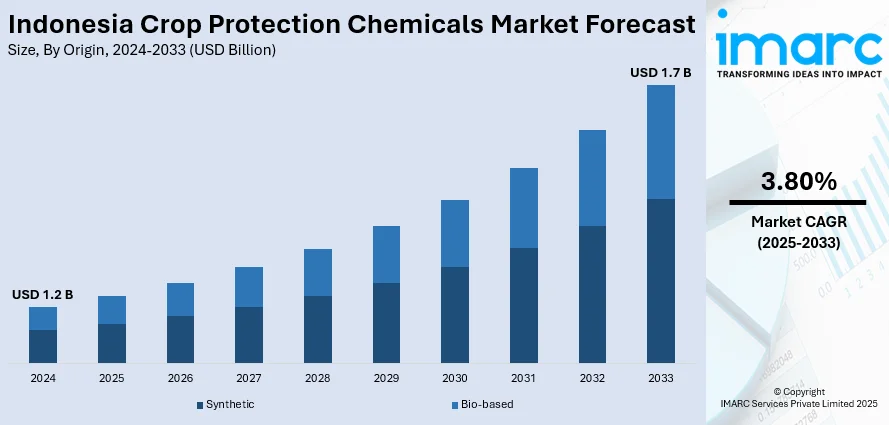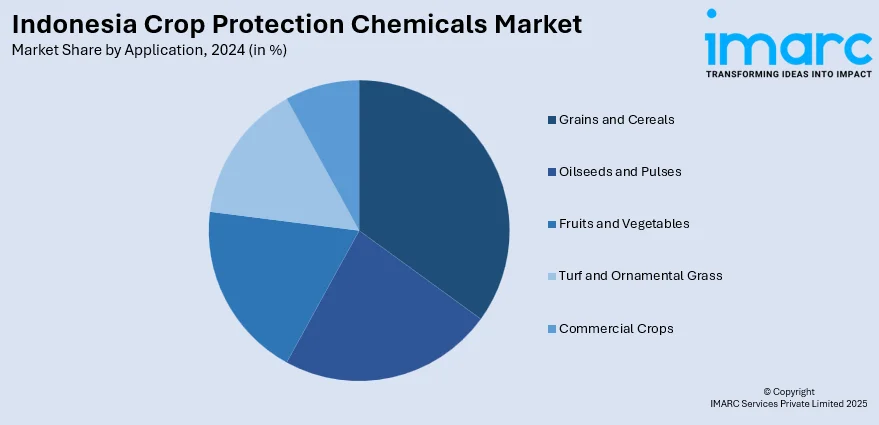
Indonesia Crop Protection Chemicals Market Size, Share, Trends and Forecast by Origin, Product Type, Application, and Region, 2025-2033
Market Overview:
Indonesia crop protection chemicals market size reached USD 1.2 Billion in 2024. Looking forward, IMARC Group expects the market to reach USD 1.7 Billion by 2033, exhibiting a growth rate (CAGR) of 3.80% during 2025-2033. The increasing population and escalating demand for food, various improvements in distribution networks and market access, and the growing adoption of GM crops, such as insect-resistant varieties, represent some of the key factors driving the market.
|
Report Attribute
|
Key Statistics
|
|---|---|
|
Base Year
|
2024
|
|
Forecast Years
|
2025-2033
|
|
Historical Years
|
2019-2024
|
|
Market Size in 2024
|
USD 1.2 Billion |
|
Market Forecast in 2033
|
USD 1.7 Billion |
| Market Growth Rate 2025-2033 | 3.80% |
Crop protection chemicals, often referred to as pesticides, are substances or chemical compounds used in agriculture to safeguard crops from pests, diseases, weeds, and other potential threats that can reduce crop yield or quality. These chemicals are an essential component of modern agriculture and play a crucial role in ensuring food security by helping farmers manage and protect their crops effectively. They are designed to control and eliminate insect pests that can damage crops by feeding on plant tissues, sucking sap, or transmitting diseases. They are also used to control rodent populations that can damage crops by eating plant parts or stored agricultural products. Rodenticides are essential for protecting grain stores and preventing crop losses. Crop protection chemicals are typically applied using various methods, including spraying, dusting, seed treatment, and soil application. The choice of pesticide and application method depends on factors such as the type of crop, the specific pest or disease, environmental conditions, and regulatory considerations.

To get more information on this market, Request Sample
Indonesia Crop Protection Chemicals Market Trends:
As Indonesia's population continues to grow, there is a need to expand and intensify agricultural production to meet food demand. This expansion often brings new areas of cultivation into focus, requiring crop protection chemicals to manage pests and diseases effectively. In addition, Indonesia’s agricultural landscape is characterized by a wide variety of crops, including rice, palm oil, rubber, coffee, and spices. Different crops face distinct challenges, and the need for specialized crop protection solutions drives the demand for a variety of chemical products. Besides, the country’s tropical climate provides a conducive environment for a range of pests and diseases that can significantly impact crop yields. Crop protection chemicals are crucial for managing these threats and ensuring the viability of agricultural production. Moreover, farmers in Indonesia are increasingly aware of the potential benefits of using crop protection chemicals to enhance crop yields and quality. They seek ways to optimize their agricultural practices and are open to adopting modern technologies. Additionally, the Government of Indonesia provides support and incentives to farmers to improve agricultural productivity. This includes programs that promote the responsible use of crop protection chemicals and provide access to these products. Along with this, the adoption of GM crops, such as insect-resistant varieties, has increased in Indonesia. These crops often require specific crop protection chemicals tailored to their unique characteristics. Furthermore, improvements in distribution networks and market access enable farmers to procure crop protection chemicals more easily. This has led to increased availability and usage of these products.
Indonesia Crop Protection Chemicals Market Segmentation:
IMARC Group provides an analysis of the key trends in each segment of the market, along with forecasts at the country level for 2025-2033. Our report has categorized the market based on origin, product type, and application.
Origin Insights:
- Synthetic
- Bio-based
The report has provided a detailed breakup and analysis of the market based on the origin. This includes synthetic and bio-based.
Product Type Insights:
- Herbicides
- Insecticides
- Fungicides
- Others
A detailed breakup and analysis of the market based on the product type have also been provided in the report. This includes herbicides, insecticides, fungicides, and others.
Application Insights:

- Grains and Cereals
- Oilseeds and Pulses
- Fruits and Vegetables
- Turf and Ornamental Grass
- Commercial Crops
The report has provided a detailed breakup and analysis of the market based on the application. This includes grains and cereals, oilseeds and pulses, fruits and vegetables, turf and ornamental grass, and commercial crops.
Regional Insights:
- Java
- Sumatra
- Kalimantan
- Sulawesi
- Others
The report has also provided a comprehensive analysis of all the major regional markets, which include Java, Sumatra, Kalimantan, Sulawesi, and others.
Competitive Landscape:
The market research report has also provided a comprehensive analysis of the competitive landscape in the market. Competitive analysis such as market structure, key player positioning, top winning strategies, competitive dashboard, and company evaluation quadrant has been covered in the report. Also, detailed profiles of all major companies have been provided.
Indonesia Crop Protection Chemicals Market Report Coverage:
| Report Features | Details |
|---|---|
| Base Year of the Analysis | 2024 |
| Historical Period | 2019-2024 |
| Forecast Period | 2025-2033 |
| Units | Billion USD |
| Scope of the Report | Exploration of Historical Trends and Market Outlook, Industry Catalysts and Challenges, Segment-Wise Historical and Future Market Assessment:
|
| Origins Covered | Synthetic, Bio-based |
| Product Types Covered | Herbicides, Insecticides, Fungicides, Others |
| Applications Covered | Grains and Cereals, Oilseeds and Pulses, Fruits and Vegetables, Turf and Ornamental Grass, Commercial Crops |
| Regions Covered | Java, Sumatra, Kalimantan, Sulawesi, Others |
| Customization Scope | 10% Free Customization |
| Post-Sale Analyst Support | 10-12 Weeks |
| Delivery Format | PDF and Excel through Email (We can also provide the editable version of the report in PPT/Word format on special request) |
Key Benefits for Stakeholders:
- IMARC’s industry report offers a comprehensive quantitative analysis of various market segments, historical and current market trends, market forecasts, and dynamics of the Indonesia crop protection chemicals market from 2019-2033.
- The research report provides the latest information on the market drivers, challenges, and opportunities in the Indonesia crop protection chemicals market.
- Porter's five forces analysis assist stakeholders in assessing the impact of new entrants, competitive rivalry, supplier power, buyer power, and the threat of substitution. It helps stakeholders to analyze the level of competition within the Indonesia crop protection chemicals industry and its attractiveness.
- Competitive landscape allows stakeholders to understand their competitive environment and provides an insight into the current positions of key players in the market.
Key Questions Answered in This Report
The Indonesia crop protection chemicals market was valued at USD 1.2 Billion in 2024.
The Indonesia crop protection chemicals market is projected to exhibit a CAGR of 3.80% during 2025-2033, reaching a value of USD 1.7 Billion by 2033.
The Indonesia crop protection chemicals market is driven by expanding agricultural activities, increasing demand for higher crop yields, and government support for food security. Rising pest pressures, adoption of modern farming practices, and the need to protect staple crops like rice and palm oil also fuel the use of agrochemicals.
Need more help?
- Speak to our experienced analysts for insights on the current market scenarios.
- Include additional segments and countries to customize the report as per your requirement.
- Gain an unparalleled competitive advantage in your domain by understanding how to utilize the report and positively impacting your operations and revenue.
- For further assistance, please connect with our analysts.
 Request Customization
Request Customization
 Speak to an Analyst
Speak to an Analyst
 Request Brochure
Request Brochure
 Inquire Before Buying
Inquire Before Buying




.webp)




.webp)












